#pose practice mostly using references
Explore tagged Tumblr posts
Text

#pose practice mostly using references#minus the chibi I just went hog wild on that one#I may redraw some of these on a much bigger canvas as I stupidly drew this on like a 700x700ish one#so they’re all hella low quality#neo oldesville#doodles#flint
11 notes
·
View notes
Text
so this is how you love

☀️Feelbokkie M.list☀️
genre: sick fic, angst, comfort, fluff
pov: 3rd person (reader is referred to in the 2nd person though)
description: a cryptic texts leads to your boyfriend coming home to find you sick in bed.
pairing: idol!jeongin x sick gn!reader
warnings: swearing
word count: 5,767
©feelbokkie (2025) — all rights reserved. reposting/modification of any kind is not tolerated.

For the first time in a long time—possibly for the first time ever— Jeongin was worried about his relationship with you.
He wasn’t at first; there was no need to be. The two of you lived a quiet life together. You went on dates frequently. He would split his time between living at the dorm and living with you. And as months went on, he spent more time living with you than at his dorm. He’d mostly stay there if it were more convenient for a schedule and so that Chan wouldn’t get so lonely. And if he had to stay at the dorm, he’d stay up on the phone with you, wishing the call would never end. When he had to leave overseas or even just out of town for a few days, he couldn’t wait until he saw you again. He’d see you in little things like the flowers or the laugh of a stranger reminded him of you. He couldn’t deny his love for you, not that he’d ever want to. He thought that everything between the two of you was fine.
“Sleep at the dorm tonight.”
The text took more energy out of his body than the choreography he had just spent the entire morning learning. It came out of nowhere, completely blindsiding him as he sat in the corner of the practice room. He tried calling you repeatedly, only to be met with your voicemail. It wasn't like you to completely shut down like this if you were mad at him. The two of you had gotten into the habit of talking things through. But if you aren't even answering his calls and banned him from coming over, like he was supposed to—
I fucked up.
"Alright, let's run the dance one more time and then call it. Whoever messes up first is buying lunch." Minho calls when he reenters the room.
Jeongin sends a quick text telling—no begging—you to call him back before shoving his phone back in his bag and joining the rest of the members in the middle of the room.
“Han, can we go to that restaurant Chan hyung was talking about yesterday?” Seungmin asks Jisung through the mirror as a large grin spreads across his face.
Jisung cocks his head to the side as he turns to Seungmin. “Why are you asking me?”
“Because he knows you’re going to be the first to mess up!” Changbin calls from the back of the starting formation.
“Hey!”
Too busy trying to push whatever is going on with you out of his head and trying to mentally run through the dance. The faster they get done, the sooner he can leave and try to figure out what’s happening. Under normal circumstances, Jeongin would respect your wishes and give you space until you were ready to talk.
Under normal circumstances, you’d at least text why you needed the space in the first place.
"Hey! Lunch is on Yang Jeongin! See, I told you I wasn't going to be the first to mess up." Jisung shouts from behind Jeongin, who is still standing motionless in his starting position.
"Huh? What? The music didn't..." Jeongin’s voice trails off. His eyes focus back as he looks at the members in the mirror, noticing that they’re all in the poses that they should be in after the music started while he's still in his starting position.
“It’s okay, that was just a practice run. It doesn’t count. Let’s just start over.” Chan walks over and pats Jeongin on the back while giving him a soft smile.
“What? That’s not fair! If I was the one—“
“That’s because you have a habit of forgetting the dance you just learned dumbass. This song is like Jjam; it starts off weird. Half of us flinched before we were supposed to move.” Hyunjin laughs as he makes his way over to Jeongin, immediately throwing an arm over his shoulder and squeezing his cheeks.
Jeongin pushes Hyunjin off of him and brushes his hair out of his face. Not an unusual thing for him to do, but the lack of even a twitch in the corner of his mouth as he pushed him off is enough to make Chan and Hyunjin share a concerned look. The other members don’t miss it either, the sudden air of tension that seeps into the practice room.
“In-ah, are you okay?” Felix asks softly as he starts to approach the youngest member.
"Yeah, I'm just tired. It's been a long day." Jeongin sighs. He runs his hands through his hair again. "It's fine. I messed up, so I'll pay for lunch. Let's just run the dance again and go,"
Everyone exchanged quiet looks with each other as they got back into their positions. It was new territory for all of them, and none of them knew exactly how to navigate around it. Sure, they've seen Jeongin upset and stressed before. But not like this. Never when he was so distraught that he couldn't focus at practice. Not when Felix talking to him couldn't bring out even a sympathetic smile.
***
The second final run of the dance goes smoothly with only minor mistakes that could be fixed during the next practice. A few more quiet glances are exchanged as Jeongin makes a beeline for his bag the second they're dismissed from practice. Chan makes the first move without realizing that the other members were looking at him to talk to Jeongin.
Chan picks up his bag from the bench before walking over to Jeongin right as he stands up and is about to leave the room. "Everything alright, In?"
"Yeah, like I just said. I'm tired. I'm not really hungry either, so I'm just going to head out." Jeongin's grip on his bag tightens as he glances at the clock behind Chan. "I know I'm supposed to pay for lunch, but I can give you my card or just pay you back."
Chan's expression softens as he watches anxiety spread across Jeongin's face. "Don't worry about that right now. What's going on? Really?"
Jeongin's mouth presses into a fine line as he glances around the room. Everyone else is slowly making their way over to their bags. Chan takes the hint and gestures towards the door. Jeongin doesn't hesitate and quickly walks out of the room with Chan close behind him. As he closes the door, he signals for the remaining members to stay inside for a minute.
"What's going on?" Chan's voice stays low, mindful that anyone could be lurking in the corners of the company building.
"I—" Jeongin cuts himself off and takes a deep breath before starting again. "I need to go to Y/n's place. They're pissed at me and I'm scared...that they might want to..."
Jeongin's voice dies in his throat as he tries to finish his sentence. Not that he wants to. A small part of him holds onto the small belief that if he says it out loud, he'd speak it into existence. The idea of you leaving him—especially because of something he might have done—is not a scenario he's ever imagined. The uncertainty of what's going on fills him with a sense of dread he's never felt before.
"Did something happen?" Chan hesitates.
"I don't know. They left a weird message and they won't answer their phone—" Jeongin lets out a shaky breath as he looks up at the ceiling, trying to stop the tears that are stabbing the back of his eyes as they threaten to fall out. "I know I'm supposed to separate my personal life with my work life but honestly hyung, I'm scared shitless right now."
Chan stops himself from pulling Jeongin into a hug knowing that the younger would not welcome the embrace, especially now. Instead, he ruffles the younger man's hair and offers a gentle smile. "Don't worry about that right now. I'm sure everything is fine. I'll cover for you with the guys, so just go and sort it out. It's probably a misunderstanding."
"Thank you," Jeongin offers Chan a weak smile before leaving to talk to you.
Jeongin half expected to find his stuff sitting outside of your shared apartment. He took some relief that the only thing in front of the door was the doormat that the two of you bought during a trip to Busan. Still, his heart continues to jackhammer in his chest as he finally musters up the courage to open the door. Whatever remaining comfort left in his body dissipates at the sight of your quiet apartment.
It’s the silence that’s unsettling to him. The only times he’s walked into a dark and quiet home are when you’re out. You disliked silence, so much so that you had a small white noise machine that you’d use to help you sleep when you knew Jeongin wasn’t going to be home or would come back after you fell asleep. During the day, there’d always be some sort of noise playing—either the TV was left on some random channel or music was coming through your speakers. But the absence of your slippers next to his by the door lets him know that you’re sitting by yourself somewhere in the dark.
My fault.
Jeongin wastes no time kicking off his shoes and placing them, along with his bag, in the hall closet. He slips his feet into his house shoes and walks straight to your room.
His heart stops pounding long enough to note the lack of white noise filling the room. It sinks to the bottom of his stomach as he makes out the outline of you curled up underneath the blanket.
As he stands in the doorway watching you, it dawns on him that he doesn’t know what to say. He spent so much time racking his brain trying to figure out what he could have possibly done to elicit such a large reaction from you that he didn’t think about what he was going to do when he saw you. Every word he’s ever learned vacates his body, fluttering away like they’re one of the moths in his stomach.
Part of Jeongin wants to just turn around and leave. You hadn’t heard him, and you definitely didn’t see him, so it won't hurt if he just walks out right now. He’s scared of what you might say. That you want to break up. That you hate him and never want to see him again. He’s not sure what he did, but he’s certain that disobeying your one wish was reason enough for you to want to end the relationship.
Still, the idea that you're home upset with him over something he most likely did is enough to bring him to an early grave. He walks gingerly towards the bed. His eyes, having adjusted to the darkness in the room, land on the crumbled-up tissues on the bed and on the floor beside a plastic bag. Something snaps in Jeongin's chest as he thinks about how you have been crying because of him.
Jeongin squeezes his eyes tight before shaking his head to get back into focus. Once he's settled, he walks closer to the bed and crouches down next to you. With his eyes level with yours, he stops to examine every inch of your face, taking every last detail just in case he never gets the chance to do it again. If he could, he'd sit there and count every eyelash and mark on your face, even the microscopic ones that even you don't know about. After a moment, he puts a hand on your back and softly rubs your back to wake you gently. Something he's done countless times, but this time it feels foreign to him.
The first few seconds cause you to stir in your sleep and pull your blanket over your face. A few more seconds pass before you pull the blanket just below your tired eyes. Jeongin doesn't stop even after your eyebrows furrow together in confusion.
"What are you doing here?" You croak softly.
"I know you said to stay at the dorm, but I think we need to talk—"
"You need to go. You can't be here." Your voice is hoarse as you get a little bit louder. You pull the blanket tighter around your face as your eyes widen, more awake now.
Jeongin stops rubbing your back but leaves his hand resting on it. "Not until you tell me why you're so mad at me."
Confusion laces your face as you process what Jeongin just said and the desperate look on his face. No matter how much you stare at him, you can't even begin to think what he could be talking about.
"I'm not mad at you. Who told you that?" You finally ask, giving up on trying to figure out what's going on in his head.
"You did," He almost whispers.
"I did? When?" Your voice is muffled behind the blanket. You rub the sleep out of your eyes with the back of your hand, trying to make sense of what's going on right now.
"Earlier, when you told me to stay at the dorm."
" No, I didn't." You sit up on your elbow. Still, the blanket continues to cover your mouth and nose. You feel about the bed, looking for your phone, hoping it didn't fall behind the bed again. You pull it out from underneath Jeongin's pillow and go to your messages. "I told you to stay at the dorm because I'm sick."
"I know what I read, Y/n. You didn't say anything about being sick."
"I know what I said and..." Your argument dies before you can even finish it as you see the message you sent to Jeongin. "Shit, sorry you're right. I didn't hit 'send' the part of the message where I said that I'm sick. But I also didn't tell you that I was mad at you."
"It was implied," Jeongin mumbles as he starts to stand up.
"How was it implied?" You set your phone on the bedside table and lie back down as the room begins to swirl around.
"The period,"
You slowly blink at Jeongin, not entirely sure if the conversation you're having right now is real or some strange fever dream. "That's...that's basic punctuation."
"Yeah but in the context of the message you sent and the fact that you didn't answer any of my calls, it meant you were beyond pissed off at me."
"Noted. I'll make sure to never use a single punctuation mark when I text you ever again and to finish my messages before I fall asleep." You bring one of your hands to your temple and begin massaging as the headache you started the day off with reminds you of its presence. "You seriously need to get out of here."
Jeongin watches you for a moment as you try to dull the pain in your head. His heart has long since settled now that he knows it was just a misunderstanding. His earlier panic has been replaced by concern for you. You're paler than he's ever seen you the entire time he's known you. Strands of your hair are sticking to your face, and he can practically feel the heat radiating off of you. Without much thinking, Jeongin hovers over you and presses his lips against your forehead, not caring one bit about the sweat.
"What are you doing?" Worried about him being so close to you, you push him off with the hand that was relieving you of your headache.
"You're really hot," He breathes as he stands up quickly.
Jeongin doesn't give you time to respond before walking to the medicine cabinet in your shared bathroom. He quickly finds the thermometer in its usual place and washes it off in the sink while searching for something to give you. The lack of any sort of medication that he could give you quickly irritates him. He shuts off the water and walks back into the room.
You flinch and move your hand to cover your eyes as Jeongin turns on the light. His eyes land on the nearly empty glass of water, half of him is relieved that you at least tried to keep yourself hydrated. Jeongin kneels back down next to you, not minding the tissues on the floor or the bed. His free hand strokes the back of your hand as he holds the thermometer out with his other hand. "You need to stick this under your tongue."
"I just need to sleep it off." You groan. You felt better when you were sleeping. You didn't feel cold, your body and throat didn't hurt, your head wasn't pounding, and you didn't have to worry about the fact that you had trouble breathing through your nose. Ignorance truly is bliss.
"Y/n, I love you, but I really need to check because you don't just feel warm. You're actually burning hot." His hand moves down to the blanket that's covering your mouth, gently tugging it away from you. "Please?"
Your grip tightens on the blanket, preventing him from actually taking it away. Your hand stays over your eyes, but you can picture the worried expression that's almost certainly painted on his face. "Can you at least put a mask on first? I really don't want you to get sick. Not what you're preparing for a comeback."
"Fine," He nods. "You put this in your mouth, I'll be right back."
You squint through one eye as you grab the thermometer from Jeongin. He walks out of the room and straight to his bag in the hall closet. He digs around looking for the bag of masks he keeps in just in case. While he's searching, the tips of his fingers graze a container. Gears turn in his head for a moment before he remembers what it was. Inspired by those Altoid tin wallets that were trending on TikTok, you took the tiny case from the Magic School collection that Jeongin gave you and made an "emergency wallet." In it were things he already kept in his practice bag: bandages, hair ties, bobby pins, Chapstick, a small picture of you, and Tylenol. He pulls it out and takes the travel-sized bottle of Tylenol and smiles at your picture before putting the wallet back in his bag.
He pulls out one of the masks and puts it on his face before walking back into the room, just as the thermometer starts beeping. Jeongin takes the thermometer out of your mouth and sets it down on the corner of the side table and pours two Tylenol pills into his hand.
"Can you sit up real quick?" He asks softly.
You slowly pull yourself up, groaning as you do with every little ache that makes itself known. Jeongin helps you up the rest of the way and props some of the pillows up behind you to help you sit upright.
"Here, take these," Jeongin places the pills in your hand. He grabs the cup of water he saw earlier and holds it out for you to take in one hand while reaching for the thermometer with the other.
He watches you for a moment as you take the pills before turning his attention back to the thermometer. His eyes widen in alarm as he reads the three digital numbers on the tiny screen. A small gasp escapes him. An ache rapidly grows in the bottom of his gut, telling them that something isn't right.
You finish taking your medicine and place the empty glass back on the side table before your eyes settle on Jeongin, who is now typing something quickly into his phone. "What? What is it?"
His voice catches in his throat, a strangled whisper that betrays the fear coiling within him as he double—triple checks your temperature. "38.9 C,"
"That's...that's not good." You whisper.
"According to WebMD, if it were one degree higher we should take you to the hospital," He pauses for a moment to continue reading. "But you should be fine. You took something to bring it down. We just need to keep an eye on you."
"We?"
Jeongin shuts his phone off and slides it into his pocket before walking into the bathroom, yet again. He takes one of the wash cloths that you use to dry your face before you start your bedtime routine and drowns it in cold water. When he walks back into the room, you're back to lying down on the bed. "Do you seriously think I'm just going to leave you alone while you're dangerously close to a fatal fever?"
"It's not a fatal fever," You yawn.
"Well, if they're saying to seek medical attention, it's not good." He whispers as he lays the washcloth over your forehead. He slips his hand into yours once he's done, stroking his thumb over the back of your hand.
"And I thought...Hyunjin was dramatic," You yawn again. You blink slowly, almost unable to open your eyes again. Exhaustion takes over your body quickly as your headache slowly but surely begins to disappear.
"Nobody is more dramatic than him. I'll tell you what he did at practice today later. For now, you should get some rest. It looks like the medicine is starting to kick in." His voice is barely above a whisper as he watches your eyes drift shut slowly, touching close several times before staying there.
"Will you be here when I wake up?" Your voice is soft as you mumble out your question, your words slur together as you drift off to sleep.
"Where else would I be?" He replies quietly to himself.
Jeongin stays there for a minute, watching the way your chest rises and falls as you take short, labored breaths while your mouth hangs gently open. His eyes linger on your face, tracing every line, etching each detail into his memory as a soft smile plays on his lips. It's different from when he studied you earlier. Each trace of your face is lined with a newfound appreciation of you. Earlier, he tried to create a replica of you in his mind with the looming thought that it might be the last time he saw you. Now, he can look at you and know that he'll get to continue to find new parts of you to admire that he didn't notice before. Like the tiny mole just below your earlobe.
After a couple more minutes of watching you, making sure that you're sleeping well, Jeongin slips his hand out of yours and begins picking up the tissues from your bed and the floor. When he gets back from tossing them in the bathroom, he takes the large comforter off of you so you don't overheat and covers you with the sheet.
In the kitchen, Jeongin checks the fridge and pantry to take note of what you have. There’s not much, neither one of you are big cooks. The two of you spend more time ordering food or eating out than eating home-cooked meals. That’s not to say that the fridge and pantry are completely empty. There are tons of snacks and instant meals, mostly instant noodles, that you could live off of if you wanted. But none of it feels right. None of the food that you have is enough to give you strength and help you fight off whatever is currently plaguing your body. You need real soup and a strong tea to help you recover.
Jeongin pulls out his phone and dials the only number he can think of right now. As the phone rings, he grabs a packet of crackers and sets it down on the counter.
"Ah, Jeongin-ah!"
A small smile spreads across Jeongin's face as the warm, familiar voice comes through the other side of the phone. "Hi Umma, how are you?"
"I'm fine, I'm fine." There's some rustling on the other side of the line. "When are you coming home?"
"We're going to have some free time after our next promotion period. I'll come down then." Jeongin places the phone between his ear and his shoulder before opening up the packet of crackers and placing them on a nearby napkin.
"With Y/n?"
He sets the crackers aside and takes your glass over to the sink. "Yeah, I can bring Y/n home with me."
"How's my Y/n?"
Jeongin brought you home with him after your first couple of years of dating. He was nervous to bring you at first. Not because of you, but because of his parents. They were more on the traditional side, and he's seen enough of what everyone his brothers have brought home had gone through to not want to put you through that. Unlike his brothers, he would make sure to talk about you with his parents a lot to ease them into the situation. Eventually, he couldn't put it off any longer when he went home for his birthday one year, and his mother asked him to bring you. They immediately took a liking to you, so much so that they tend to invite you to Busan without Jeongin. Your relationship with his family is one of the things he loves about you.
"That's why I'm calling you, actually—"
"Yang Jeongin, what did you do?" The stern tone is enough to send a chill down Jeongin's spine. Suddenly he's 5 years old again, getting scolded for doing something he definitely should not have done.
"I didn't do anything, I swear!" He whispers loudly as he switches his phone to the other ear. He peeks over to your room to make sure he didn't wake you up. "Y/n has a really bad cold right now and I was wondering if you could tell me how to make that soup you made us eat? And that pear you gave us."
"Goodness, my poor Y/n...I'll make some right now and bring it." He can hear her moving around again, probably heading to the kitchen.
"Umma, that's unnecessary. I can make it myself if you tell me how to."
A small chuckle rings through the phone. "You're willing to listen to me? My Y/n's changed you."
Jeongin pauses for a moment and glances back at the bedroom again. Jeongin knew he loved you. Being with you taught him more about himself than he ever knew. He didn't know how much he craved your touch, even if it meant a simple stroke of your hand against his cheek. He didn't realize how much he enjoyed your late-night conversations where you'd talk about your day. How you could make every little mundane thing, like going to the grocery store, seem so grand. Or how you'd sit there and explain the plot of whatever show or book you were into at the moment, just so he could understand the rant you were about to embark on. He didn't expect that the combination of your shampoo and body wash would be his favorite scent in the whole world. That he's purposely lent you his hoodies and shirts to wear so they could smell like you. He didn't realize how big and cold every hotel bed and even his bed back at the dorm felt. He didn't expect to feel like he ran a marathon every time he saw you, especially after he had been gone for a long time. He didn't know that it was possible to love someone this much. Not until he thought he was going to lose you.
His voice softens, a tender melody expresses affection slips off his tongue. "Yeah," "Okay, get a pen or put this into your phone. My samgyetang and baesuk are difficult and I don't want you to poison my Y/n."
***
Jeongin nods quietly to himself as he sets the spoon aside. The samgyetang doesn't taste as good as his mom's, but it's good enough to give you.
Everything took longer than he had anticipated. First, he had to order all of the ingredients that you didn't have. Which, except for salt, pepper, and glutinous rice, was everything. Trying to figure out how to get the giblets out of the chicken and clean it out was the next difficult task. Not because it was complicated, but because of how disgusting the entire process is. How he didn't wake you up with all the commotion is a mystery he'll never solve. He held off making the baesuk for now, wanting you to have it as soon as it was done, and instead made some ginger tea.
"Innie?"
"Oh, you're up," Jeongin quickly walks over to the sink and washes his hands before fully turning to you. A small sigh of relief escapes him as he looks you over. Some of your color returned to your face and you look a bit more well-rested. Even in your poor condition, the way your hair is tousled all over the place and how his shirt hangs off your frame has him melting at the sight of you. He keeps his distance from you, not wanting to get scolded again even though he's still wearing his mask.
Before either one of you could say anything, tears quickly well up in your eyes and begin to pour down your face.
Jeongin wastes no time, not even pausing to dry his hands before walking over to you. His face is laced with concern as he cups your face. He pulls down his mask and presses his lips to your forehead again. You still feel warm, but not as hot as you were when he first checked. Furrowing his brows, he pulls away and wipes away your tears with his thumbs. "What's wrong? Are you feeling that bad?"
You quietly shake your head while sniffling. Your crying, on top of the congestion from your cold, makes it harder for you to breathe and causes you to nearly choke. One of Jeongin's hands finds its way to your back and begins rubbing a soothing circle, trying to calm you down.
"S-sorry, I don't know w-why I'm crying so hard." Your voice sounds a bit more gravely than it did earlier, and it hurts a bit more. Still, you take a deep, shaky breath. "I thought I was dreaming that you were here earlier, but seeing you made me realize that you're really here."
Jeongin pulls you into a tight hug against his chest. "Why wouldn't I be?"
You stay silent, not that he needed an actual answer. Instead, you bury your face into his chest and grip the hem of his shirt with both hands. The thumping of his heart against his chest is enough to calm you down.
Once he's certain you've settled down enough, Jeongin leads you over to the couch. There's a blanket and two pillows folded neatly on one of the cushions. He props the pillows against the armrest and makes you sit up against them before covering you with the blanket. He hands you the TV remote before disappearing just barely out of your sight in the kitchen.
He leans against the kitchen sink, holding one hand over his chest, trying to still his beating heart. After a couple of minutes, he grabs the pair of matching mugs that you surprised him with after he came back from an overseas schedule. You found them in an old thrift shop one day on your way home from work. One cup is covered with little sticks of butter, while the other one is covered with slices of bread. You couldn't resist the urge to buy them. They're not Jeongin's style, but his bread mug is his favorite cup.
He pours tea into both mugs and brings them back over to the couch. He places your mug on the coffee table and keeps his with him while he takes a seat in the nearby recliner.
"You really should go back to the dorm. You can't afford to get sick right now." You mumble as you play with the remote in your hands.
Jeongin takes a cautious sip of his tea before settling into his seat and pulling his mask down a bit further on his face to keep it dry. "Don't worry about that right now."
"But—"
"You shouldn't even be talking right now. It's not good for your throat." Jeongin leans forward and gently pushes your mug closer to you. "Drink that and put on that show you were telling me about the other day. The one about the two doctors who were rivals in high school."
You let out a defeated sigh, knowing that Jeongin is right. Your throat has been killing you and talking only makes it worse. You grab your tea and turn to search for the drama that you started the other day.
As the drama plays, Jeongin is watching you more than he is watching the TV. Watching you silently react to what's happening on the screen is much more enjoyable than whatever antics the doctors are getting into right now. It's almost as if time has stopped. If Jeongin isn't careful, he'll lose track of time and ruin the food he made for you.
"I'll be right back," He whispers mostly to himself. You're too engrossed in the show to hear him anyway.
Back in the kitchen, Jeongin turns the fire off under the soup and begins steaming the pear for the baesuk. He pours the soup into one of the bowls that the two of you bought together when you decided that you needed a proper set of dishware for your apartment. He sets the bowl on a serving tray along with a spoon, some napkins, and a few more crackers.
Contentment flows into each step as he walks back to you with your food, a faraway, loving gaze fills his eyes. When he's back in front of you, a smile is plastered over your face at something that happened on screen. Noticing that Jeongin came back, you fill him in on what he missed. He can see your lips moving and hear your voice, even in its damaged state, ring in his ear like a sweet melody but his brain isn't registering what you're saying.
"I love you," He says suddenly.
You're thrown off for a second by the spontaneous confession, but quickly recover with a large smile that didn’t just light up the room; it set off fireworks within Jeongin's soul. "I love you, too."
—
Buy me a coffee?
—
Permanent Taglist (closed)
Red means that it wouldn't let me tag you (either at all or properly)
@amyysfics @berryblog @jaydebow @junebug032 @boiohboii
@heistheavatar @lieslab @rainbae-anon @k-cock @hamburgers101
@mrswolfiechan @soulboundauthor @weird-bookworm @thisisnotjacinta @seungmyynie
@halesandy @kpopsstuffs @honeydew93 @beebee18 @stay278
@jaiuneamesolitaiire @babrieeee @brain-empty-only-draken @tenmii @blueforte
@jihanlovic @felixglow @nuronhe @eunseok-s @soonyoungblr
@phtogravi @jiisungllvr @puppyminnnie @velvetmoonlght
#feelbokkie writes#stray kids#skz#i.n#jeongin#yang jeongin#skz imagine#stray kids imagine#jeongin imagine#i.n imagine#yang jeongin imagine#skz imagines#stray kids imagines#jeongin imagines#i.n imagines#yang jeongin imagines#x reader
320 notes
·
View notes
Text
A Quick Guide to Handling an Academic Rivalry
Kep1er’s Kim Dayeon x Male Reader
800 words
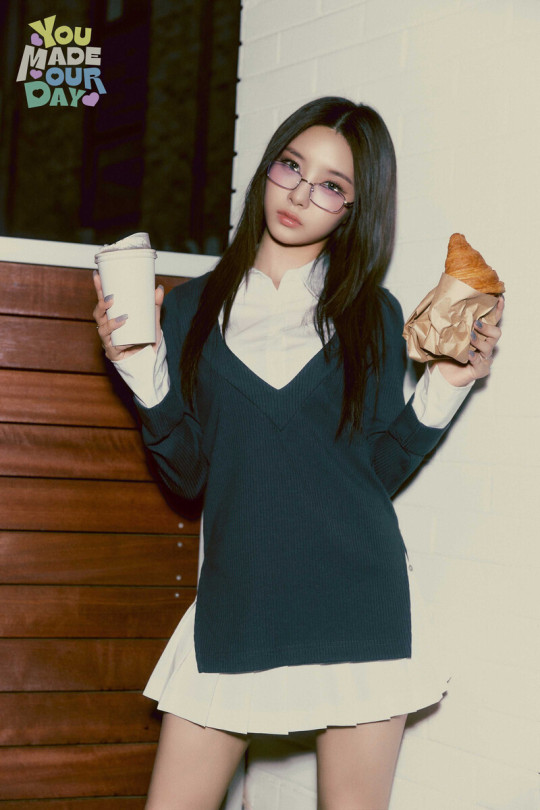
A/N: Another practice piece! This Dayeon really makes me go :dentt:. Thanks to kdollikesthighs for beta-ing again! I used capslocked's Vanity as my reference this time, so you'll find a lot of similarities between this and their work. Thanks for your support as always!
—
Your relationship with Kim Dayeon has been, to say the least, strained—academic rivals and all—sticking out tongues whenever you walk past each other in the hallway, calling each other names when drunk. It has mostly been an equal fight.
This time, though, you seem to have the upper hand here.
“This–This doesn’t erase the fact that you jerk off to–ow–kpopfap GIFs!” Dayeon sneers, exclaiming as her rear is smacked.
“I only read smuts, bitch,” you growl, giving her ass another spank while burying your hard length into her pussy. Dayeon is on the majestic pose of all-fours here. Her back arches gorgeously as you’re plowing her from the back.
“Ow! That’s equally bad!”
“And you’re still letting me hit, Kim.”
“And–And you should be–” she stutters, and there’s a snark there, even if the tremble in it says otherwise, “–thankful!”
You let out a groan, both in the pleasure of fucking her and how she keeps on the seemingly endless banter. Admittedly, it’s a little entertaining.
Your cock pulses inside her as you thrust back and forth into her wanton cunt, sending jolts that light your synapses aflame. You find yourself moving faster, hitting deeper with each wet plunge, hands gripping onto her waist tighter and tighter. Dayeon wraps and grips your cock with such indescribably perfect warmth.
You cup Dayeon’s breasts between your fingers, squeezing the putty skin harshly. She seems to love it, even if the strained yelp tells another story. The sound persuades you to find her stiff nipples, rolling them between your fingertips.
“Fuck! Oh God, not my tits!” she barks, though the stutter gives away the pleasure blazing inside her.
“I’m trying to make you cum here, slut,” you shoot a bite back. The sound of flesh slapping into each other fills the room. It’s ugly. It’s obscene. It’s also fucking satisfying.
“It’s because your dick is fucking tiny, loser.”
It’s averagely sized, you’ve measured it a fair few times out of curiosity and insecurity. You don’t give her a reply, though.
Reaching forward, you find the hollow of her throat with your hands. You give her a little press on her trachea, not enough to choke her, enough to make her walls contract around your cock frantically, spilling juices all over her own bed.
Voice all breathy from the light choke, she utters, “Fuck.” The next words are less and less cohesive, curses, nonsense, god’s name (you swear that your name comes out at one point, though she’ll probably deny once the sun rises). She needs a release. She needs to cum.
“Gonna cum, gonna cum, gonna cum,” Dayeon cries, body writhing in your grip.
“Fucking–Fucking cum, slut,” you growl, putting more pressure on her throat. You can feel her pussy pulsing around your cock.
She can barely form a sentence in full, moans overtaking coherent words, debauched and husked as she struggles to offer a riposte, “I’m not–I’m not your slut, fucker–ah!”
Dayeon wails. Her body goes rigid, collapsing on her own bed. Juices spill onto the bed sheets, wetting them all over. They’re not yours, anyway, as if you’d care.
“Fuck!”
You continue to fuck her through her orgasm, plowing her spent cunt relentlessly. The warmth envelops you. Dizziness takes over you. You don’t know how to describe the sounds leaving your lips as the tension in your loins rises.
“Fucking slut–”
You erupt, fucking your cum into her needy cunt in ecstasy. The wet, obscene sound of your cock sliding in and out of her pussy combines with your guttural groans, echoing through the room. You take in the image of Dayeon lying on her own bed, naked, ass up in the air, taking in your essence into her womb. You feel each shock from your hips sending your hot, sticky release deep into Dayeon.
Your movement slows down, with your cock resting inside her. You drag your shaft out of her used cunt. The mixture of your juices leaks out of her wet cavern onto her own bed, making soft plops sound as the droplets make contact with the sheets. Your body then collapses beside hers as you watch her basking in the afterglow.
She sneers, voice all breathy after the scream, “This–This doesn’t mean we’re good now or anything, loser.” Her face is still buried in the pillow, struggling to prop herself back up with her weakened arms.
“Sure, sure.” You sit up to give her reddened ass cheeks another smack, making her moan feebly as you get off from the wet bed. “Fucking slut.”
—
411 notes
·
View notes
Text


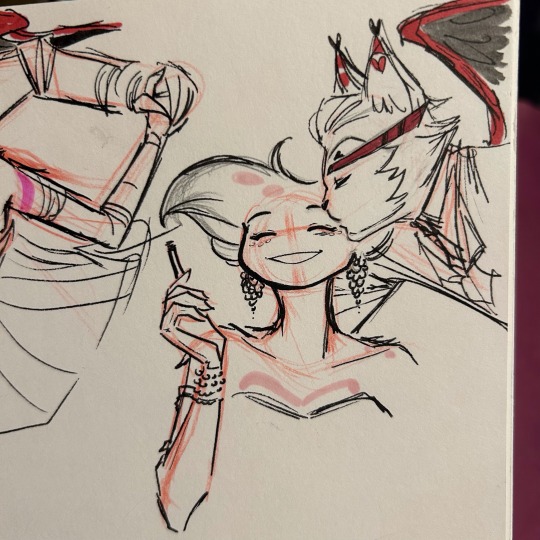
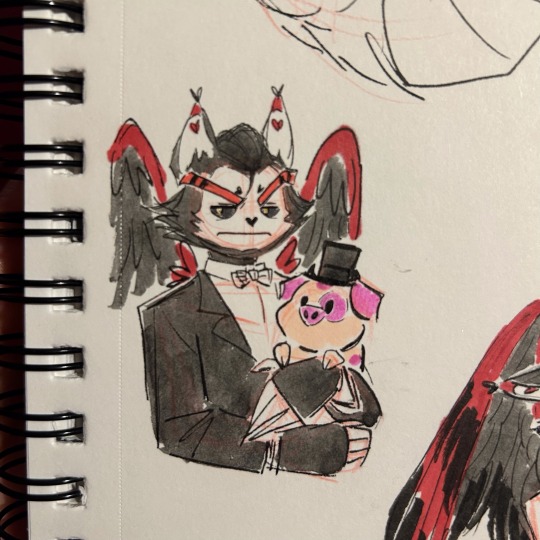
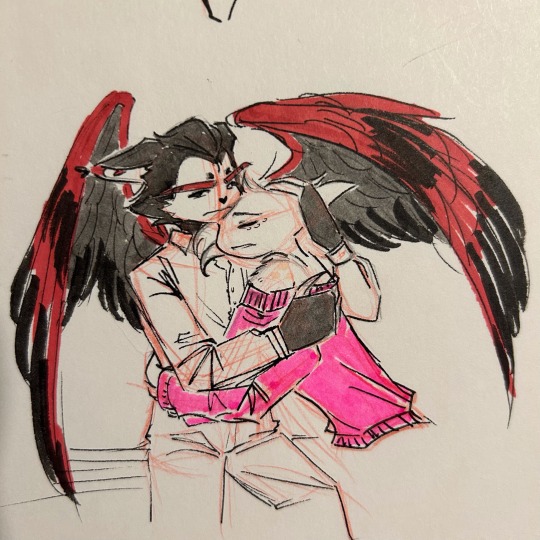




More Overlord!Husk AU
@celestialalpacaron - I'm not sure if you fully understand the scope of the ART MONSTER you have unleashed with this idea.
But just got some practice with quick sketches using reference photos - mostly of Frank Sinatra. (Included those too for comparison.) I think my favorite is the waltz one, because I am a SUCKER for ballroom dance. ❤️ And ballet. And jazz. And dance in general. You get such WILD and beautiful poses.
Description below the cut!
[IMAGE DESCRIPTION: a collection of ink sketches of Husk and Angel in the Overlord!Husk AU. One sketch is an overhead view of Husk and Angel waltzing, as they rest their heads on each others' shoulder. One is of Husk kissing Angel on the temple. One is of Husk scowling while holding Fat Nuggets, who's wearing a tiny top hat. The last is of Angel and Husk sitting together, wearing more casual clothes, with Husk comforting Angel as he leans into him, and has one wing curled over him.
The next four are close-ups of each sketch. The next four are the reference photos used.
END DESCRIPTION]
#my art#sketches#traditional art#photo references for the win#hazbin hotel#hazbin hotel fanart#hazbin hotel husk#hazbin hotel angel dust#huskerdust#angelhusk#husk x angel dust#hazbin hotel fat nuggets#overlord!husk#overlord husk au#sometimes you just gotta churn out sketches really fast and don't care about making mistakes
750 notes
·
View notes
Text
Some Art Vocabulary

Abstract - Simplified, intended to capture an aspect or essence of an object or idea rather than to represent reality.
Amber - Tree resin that has become a fossil. It is semi-transparent and gem-like. Amber is used in jewelry today as it has been for thousands of years.
Amulet - Object, organic or inorganic, believed to provide protection and turn away bad luck. Amulets were often worn as jewelry in antiquity.
Anneal - To heat metal to make it soft and pliable.
Black-figure - Technique of vase painting developed in Greece in the 7th and 6th centuries BCE and adopted by the Etruscans. Figures are painted on a reddish clay vase in black silhouette and details are then cut away with a sharp point down to the red below. Sometimes artists added additional colors, especially purple-red and white.
Bronze Disease - Corrosion of a bronze object that cannot be permanently stabilized. Without special care, an object with bronze disease will continue to corrode.
Bust - Portrait of a person including the head and neck, and sometimes the shoulders and part of the chest.
Cameo Glass - Glass produced by layering two or more colors of glass. Generally, an upper layer of white stood out against a contrasting lower background, usually blue.
Cameo Stone - Hard stone, such as agate, naturally layered with bands of color. Artists took advantage of the layers to carve figures or decoration from an upper layer (or more than one), leaving a background layer of a different color.
Cast - To make in a mold from liquid metal. A cast object can be hollow or solid.
Chasing - Technique of adding definition and details to an image or design on metal from the front using blunt and sharp tools.
Conservator (of antiquities) - Professional responsible for preserving ancient objects and materials. Conservators usually have a general knowledge of chemistry and of ancient art-making practices and are often specialists in one material. Among many other responsibilities, they conduct technical and historical research and oversee preventive care such as climate control.
Contrapposto - (”opposite” in Italian) Pose of a standing figure with most of the weight on one leg and the other bent. This causes hips, shoulders, and head to shift in order to balance the body. One arm is often higher and one lower.
Emery - Hard, dense rock rich in corundum, found easily on the Cycladic Islands. A powerful abrasive for grinding and smoothing other stones.
Encaustic - Technique of painting using colored pigments mixed with wax. The waxy mixture was worked with a tiny spatula.
Gild - To apply a thin layer of gold foil or liquid gold (gilt) to create the look of solid gold.
Iconography - Study of and use in art of repeated images with symbolic meaning.
Incise - To press or cut into a surface (stone, metal, clay, wood) with a sharp tool to write text or create fine curving and linear details.
Inlay - To decorate an object by inserting a piece of another material into it so that it is even with the original surface.
Low Relief - Method of carving figures or designs into a surface so that they are raised slightly above a flat background.
Mosaic - Technique and type of artwork. The technique is to arrange cubes of stone, glass, and ceramic to form patterns and pictures in cement, usually on a floor. The artwork is the final story or decoration made of cubes.
Mummification - Process of preserving a body by drying it. The Egyptians removed internal organs and put natron, a natural mineral mixture, on and inside the body. This absorbed moisture and prevented decay.
Palmette - Stylized palm leaf used as decoration in ancient Greek and Roman art and architecture.
Pentelic - From Mount Pentelicus, near Athens. An adjective that mostly refers to the beautiful white Greek marble marble in its quarries.
Portrait - Image of a person, usually the head and face. Some portraits include part of the chest or show the whole body. The image may closely resemble a person or emphasize, idealize, or invent characteristics.
Repoussé - Technique of raising the outline of a design on metal by repeatedly heating and softening the metal and pushing the desired shapes into it from the back with a blunt tool.
Sarcophagus/Sarcophagi (pl) - Stone coffin, often decorated on the sides with mythological scenes carved in relief, sometimes with the image of the deceased person or couple on the lid. Used in Imperial Roman times from the early 100s into the 400s CE.
Stele/Stelai (pl) - Upright stone or wooden slab or pillar used to honor a person or mark a place. Often an inscribed grave marker or a boundary stone. (Also called stela/stelae.)
Syncretism - Blending of elements of different cultures, often resulting in new imagery or new interpretations.
Tessera/tesserae (pl) - Pieces of stone or other hard materials cut into squares or cubes to make mosaic art.
More: Word Lists ⚜ pt. 2
#art#terminology#word list#writeblr#dark academia#writing reference#spilled ink#literature#writers on tumblr#writing prompt#poetry#poets on tumblr#writing inspiration#creative writing#light academia#langblr#linguistics#jan matejko#romanticism#art vocab#writing resources
293 notes
·
View notes
Note
Do you have any advice or tips with drawing? Any will help me I hope you have a good day
I think it would help to analyze references in the beginning, to build up a visual library

I was taught at university to first see the general masses, the silhouette. This method is called “general to particular”. And due to this stage, it is much easier for you to perceive the image, the composition as a whole, rather than running straight away to draw eyes, hands or other details
Starting with a silhouette also helps to create character designs in the future ✍️

Then you can already outline the construction, the middle forms. Again without small details, but you can leave a hint of them with the help of auxiliary lines.
I don't really work with tone so much at this stage, I just showed you how you can even use it to outline light shading (also common masses)

It also helps to do chopped, rough construction with a couple lines. I would generally advise practicing confidence in hand movements and understanding of general shapes. How clean your sketches are will help you navigate more easily in the future. And general shapes affect mostly how you can stylize body parts, how you understand their construction based on simple geometric shapes. It's a mistake to think that working with a reference is a one-to-one repetition of the original image. Artists use some kind of distortion of proportions, changing details or a little pose based on experience to make a character or work more dynamic

And then you can go into detail 💅
--------
I mean, already as in my experience I say that repeating or re-learning the base, which is lines, shapes, improves your drawing skill.
Because the faster you get through sketches, the faster you can move on to other stages of drawing, and still make fewer fundamental mistakes
And if you want to study anatomy, plastic anatomy would be the way to go for artists. I worked up my anatomy by looking at books and tutorials from the authors belowotome ↓


The authors of this book post tutorials using 3D models on Pinterest and ArtStation
I realized for myself that I am not a classical artist, that learning from the works and books of old academic masters is boring and not interesting to me. My approach is to analyze not only nature, but also 3d models. Analysis of 3d models helps with understanding of shapes in space, light shading and “what are occlusions” for game rendering ↓

Like this :D. But this is already relatively my old work and now I can do better, but I'm lazy
I hope my tips were helpful 🗣️
134 notes
·
View notes
Note
how do you do anatomy? it’s something i really struggle with OTL
and all of your poses seem really fluid!! and good!!
also your handwriting is so pretty 👀
UNFORTUNATELYYY the more you practice the more you improve (booooo!! 👎🍅🍅💥) but ofc I can’t say I’m even that great at anatomy either. I still use references whenever I can because you can never be too sure ^^
So I can’t really give a lecture on anything anatomy related bc shrugs shoulders buut I can show you how I trace effectively (in a way that actually teaches something I think). This is how I learned how to make fluid poses and how to connect body parts. Let’s start with a pose and make a lower opacity frame of it as well.

There’s two ways I go about tracing a pose. Option 1: Structure first, Action second. I’ve posted about this method before but it’s mostly just making a frame for the later details. Pretty boxy and rigid, no details.

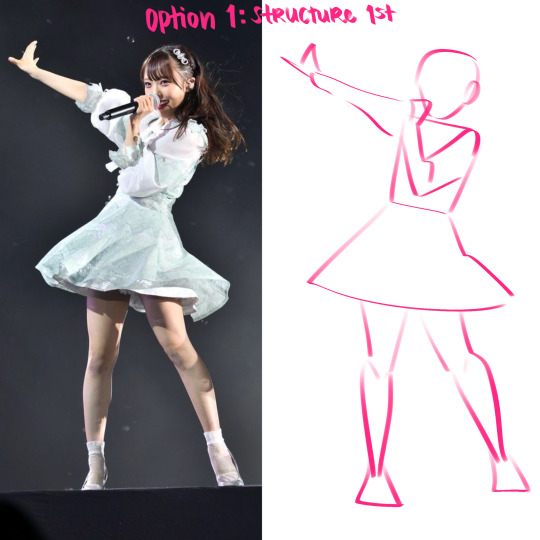
Then (without the bg image) add more fluid details using reference image to see where movement is most evident.
Then boom!
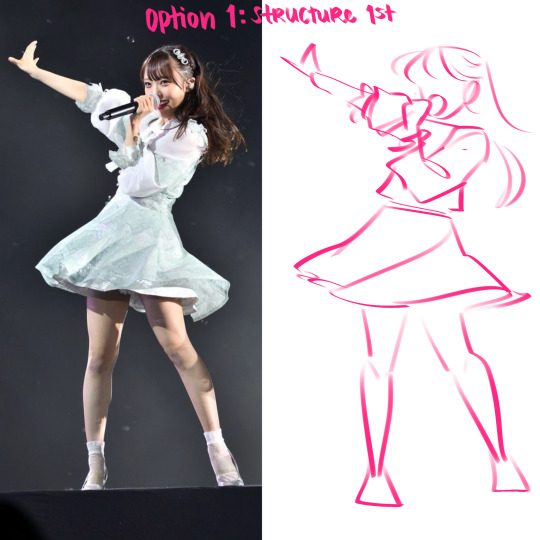
Option 2: Action first, Structure second. Kinda obvious. Focus first on where movement appears, avoiding overly straight lines and too many details.


Then add the structure necessary to complete the pose.

In the end you get pretty much the same image from the same pose in either option so it’s up to you which one you prefer.
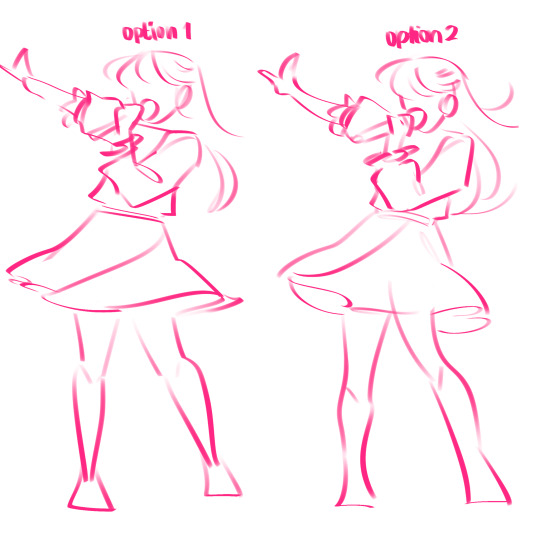
Aaaaaand that’s how I trace for a pose! It’s great practice for anatomy as well as it forces you to ignore details and look at overall shape. Tracing isn’t evil if you use it effectively, but avoid using other artists work without permission since that’s when plagiarism muddies the water. Use photos to practice quick studies and soon you’ll be drawing things without a second thought!

Also thank you! I hope this helps at least a little
#I hope this isn’t a ‘step 1: be good at art’ situation#I promise this was and is still how I practice poses ;;#Art tips#anatomy#art study#procreate#my art#peachie asks
235 notes
·
View notes
Text
》 [ yandere!Jock. ] 《
masterlist.
yan!jock x gn!reader: introduction. 1273 words. reader referred to as 'you'. cw for general yandere behavior.
DO NOT USE OR REPOST MY WRITING ANYWHERE.

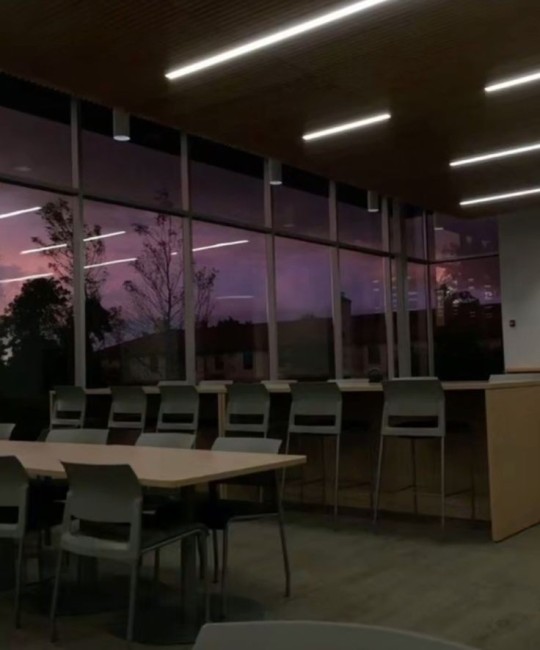
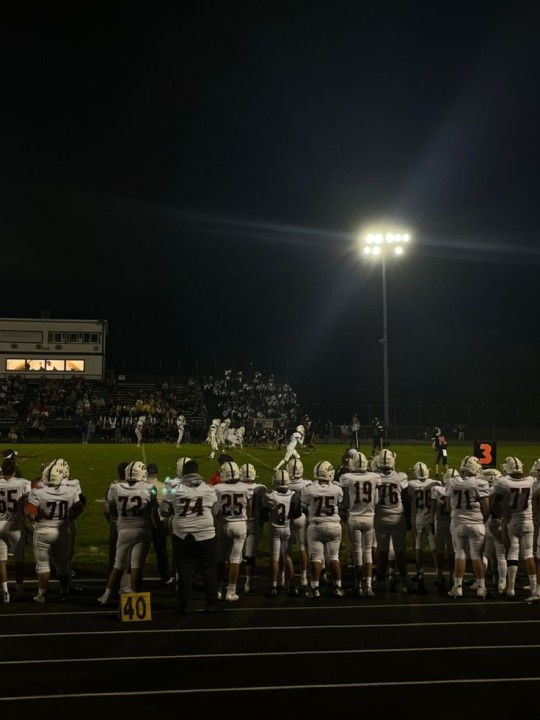


elijah steele is the best goddamn actor in your school.
the theatre kids could learn from him, honestly, because there is no way in hell anyone else could have convincingly pulled off what he did: pose as the nicest, most helpful and kind student in the entirety of the sorry shithole that is eastview high for four years straight.
to literally everyone, elijah is so sweet it's almost vomit inducing. the school's golden boy — smart, nice, strong. best player on the football team, co-captain of the swim team, and part of the basketball team for good measure, helpful, always cheery, and he got good grades.
even amongst his peers, he was always considered the most straight-edge one; still, he was pretty much universally liked. he was genuinely friends with everyone, never judging or turning anyone away.
what's not to love?
well, probably the fact that all of that is a lie, an ever on-going act. a carefully crafted persona, custom made to hide the fact elijah steele is a colossal prick.
it's honestly almost too easy for him. help teachers out here and there, talk to the right people, go to the right parties, and play on some teams, and boom, the entirety of eastview wrapped around your finger. he's made high school a game for himself, and he has been winning for four years straight.
elijah's obsession with you didn't kick in right away. he saw you and was... eh, rather neutral. he decided you were pretty enough, and homecoming or some other stupid dance he didn't actually care about was coming up, so he needed a date to look good. you were just a pawn, after all, no different from anyone else. an accessory — good-looking and non-threatening enough.
no, the obsession started when you rejected him.
worse than reject him: you saw through the finely crafted veil he's always putting on — through the smile that's as fake as it is charming, the tone of voice that's almost a bit too nice — you saw through it all, and didn't hesitate to let him know.
and oh.
it hurt.
with a few words and an unimpressed look, without even realizing it, you broke elijah's game. you weren't playing along. and hey, he might be a prick, but he's a prick with feelings. a lot of very conflicting feelings, as it turns out; he's dealt with rejection before, but never when it came to relationships.
he probably should have seen the hurt he felt when you rejected him as a sign of what was coming, that being the growing obsession he can practically feel developing. you made him feel something other than smug superiority and mild annoyance. it wasn't anything pleasant, sure, but it was new. the week after that little encounter of yours, you were literally the only thing he could think about.
at first, it was a mixed bag. elijah was confused, weirdly hurt — he discovered he didn't like feeling either of those much — and angry. mostly angry. that was the only emotion he was really familiar with of those three, so he thought he would be able to use it pretty easily. he does football after all, he'd just tackle whatever poor sods that were unfortunate enough to be going up against him in practice and get it all out of his system. easy, right?
it wasn't easy.
he nearly dislocated a guy's shoulder before realizing that his usual method for dealing with his feelings — channeling them into brute force — wasn't working, which only made him more confused, which in turn only made him angrier. so used to being in control, elijah didn't know what to do with himself for the first few days.
fortunately for him and the rest of the eastview football players, his anger, hurt, and confusion subsided after maybe a week and a half, giving way to another unfamiliar, but much more welcome emotion: fascination.
you still occupied his thoughts constantly, but he finally got a break from the all-consuming contempt he felt. instead, he regarded you with intrigue, a curiosity. it was then he decided he had to learn more; you were an obstacle, a challenge. another part of the game.
he just had to figure out how to beat you.
in some strange way, elijah was excited. this was going to be hard, sure, but his mind was already hard at work, and he was sure it would eventually be rewarding.
and hey, most importantly, this was new! his rage turned to pure goddamn delight at the idea of someone who finally isn't drooling all over him. it's so fun! like a specimen for him to study, aren't you, darling? finally, he has to work for someone's favour.
once elijah comes to this... decision? realization? he gets started pretty much immediately. he knows now that the overly sugarcoated golden boy persona isn't going to work for you. he's going to need a new strategy, and he's giddy to get to work on it.
with negative hesitation, he starts stalking you. honestly, he probably starts stalking you before he actually buckles down and starts trying to win you over; at some point in the bafflement that comes with you not immediately falling for him, he just starts to follow you around from a distance, almost absent-mindedly making notes on your schedule, your friends, class mates, teachers... he decides to double down after that, though, deciding that if he's serious about beating you, he's going to have to up his game.
that's when he starts actually following you home, taking note of your family and your behavior outside of school.
the second thing he starts doing is shadowing you outside of stalking. that meaning, he starts sitting with you at lunch, making friends with your friends, switches classes to have them with you, and joins your extracurriculars; and he does so with the most smug, shit-eating grin on his face.
he starts talking to you as if you were one of his friends, and even though you knew that elijah was probably less nice than he seemed at first glance, you didn't realize just how starkly different his real personality is from the persona he puts on.
elijah starts to treat you more genuinely, in a way. he talks shit about his friends to you, bitches freely about all his classes and coaches. it's a distinction that would feel sweet, if not for the cognitive dissonance that comes with watching him be all smiles with someone right after he told you he hates them.
because here's the thing — now that elijah knows you're not fooled by the overly sweet and helpful guy he pretends to be, that his polite golden boy act won't work on you like it does with everyone else; now, he can stop pretending.
it's freeing. hell, it's almost more fun that way.
he wants to win with all of his cards out on the table. every nice, kind he does to make you like him will be colored by that tension, that dissonance, that confusion.
of course, elijah would never admit it, but slowly, as he makes friends with you, his obsession with you turns romantic. his intrigue turns to sincere care and affection. he doesn't realize it until he sees someone flirting with you — or worse, you flirting with someone — and jealousy hits him like a fucking brick.
he's left to collect himself, once again feeling hurt, angry, and confused at his own thoughts. he didn't even like you. you were supposed to be just a game, a challenge, an obstacle.
what the fuck was happening?

826 notes
·
View notes
Note
do you have tips for drawing armor? (specifically guardian armor but armor in general works too)
Wow this is the first time i got asked about art related question. Life achievement get. Also please allow my rambling.
Tbh, there's... not that much real advice i can give? I mean, the best thing about drawing armor is that there's almost no organic stuff (e.g., facial / eye expression, muscle, etc) and you can just copy the reference. I'll try, but idk if this is what you're looking for
Basic / General Section
Because drawing armor is basically just "slapping a skin on a figure by copying the reference mindlessly", you need quite a few basic "things" to actually do that well enough:
A base figure (to slap the armor on. If you're good you could probably just freehand the armor directly but i cant. Draw the figure now so you can mindlessly copy-paste the armor on it later)
Reference (if you're drawing that armor set for the first time definitely don't use your memory. Just get a set of reference and stare at it and copy each piece you see. I would use destiny 2 model archive, open in blender, render enough reference i need and post them in PureRef. You'd probably need: 8 angles for the body, 8 angles for the head (zoomed in), the inside part of the arm and leg, and maybe more variated angles for the head. By 8 angles i mean front back left right and the 4 in the middle)
Perspective skill (this is generally important in drawing, but for armors (which is mostly about inorganic stuff) this probably matters a little bit more. For example, the shoulderplate might be in weird angles when the character move their arm and you should make sure you can draw that in these weird angles. The general advice would be to just go to drawabox.com and learn as much as you can, at least part 1 lesson 1 and draw (a bit of) 250 boxes challenge?)
Btw, by "copying reference" i don't mean "pose the character in game or in blender and copy / trace the pose and things exactly what you see", i mean "you shouldn't just imagine the armor pieces and clothe design of the character, you should know what the design looks like by seeing a reference and copying its design"
And that's it. Go slap some armor on some figures... Okay maybe I should give some examples.
Let's use these 2 as examples
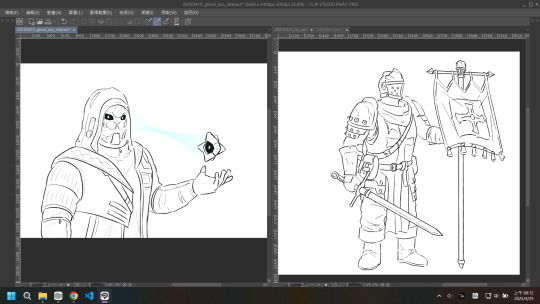
So first of all, who are these people anyways? They are the Limitless Subversion hunter set (& exo chassis & ghost) and Reynauld from darkest dungeon, so you should probably go and prepare your reference now.
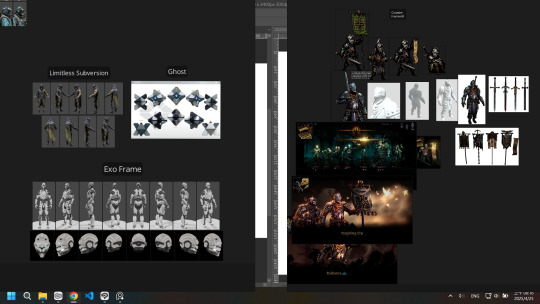
Now the least fun part imo. Drawing the figure.
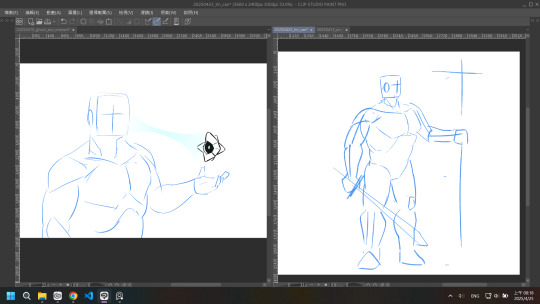
"Least fun" because all the proportion, motion, perspective information, and just basically anything should be dealt with at this stage and i'll be more and more unconfident in my figure drawing and perspective skill as time goes on. The rest of armor is just detail that you can mindlessly slap on the figure later.
probably should make things more block-y to see what i mean by perspective

not perfect but you get the point. you should know which direction the arm / leg / torso is facing so you can slap the armor at the correct position and angle.
...tbh that's just part of the figure drawing skillset. you also need that when you slap muscles on a figure
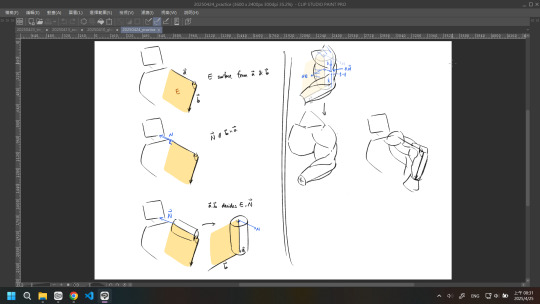
(just a random example for my practice note don't actually try to figure that out it's probably wrong anyways)
As for how exactly to do the figure drawing... there's tutorials literally anywhere and each person has their own way to do that. can't really help you with that, go google some videos or just crunch the andrew loomis figure drawing book. free online btw. Also anatomy helps a huge ton even if youre not actually drawing muscles.
And the next step is just stare at the reference and copy the armor pieces on the figure
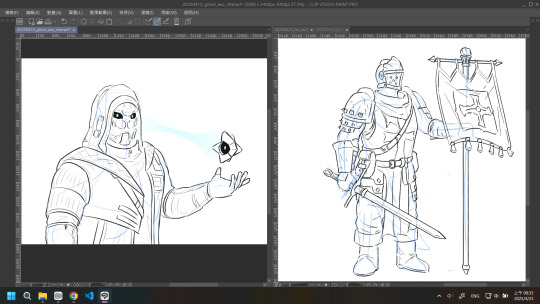
that seems like a big jump but tbh we've dealt with the most difficult part in the figure drawing section so this is just mindlessly drawing now. the general advice i can give is to get a dual monitor (to not clutter the screen with reference too much), try to understand what each piece looks like in 3D, make sure the armor pieces is in the right orientation, and (do your best to) figure out if what you're drawing would violate the perspective rules you learned before (which should also be dealt with in the figure drawing part)
Detail / Niche Advice Section
we are talking about armor and clothes and outfit stuff so there should be a lot of niche detail stuff that would be beneficial to do or learn
the things i can think of now are these
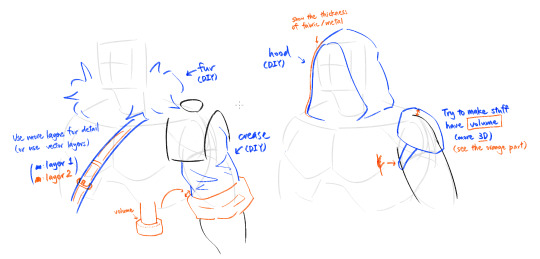
DIY (do it yourself) means this is a common topic and there should be some tutorials online or in books (e.g., fur, crease), or just do it a bunch of times and you would somehow get the gist of it (e.g., hood). (i kinda hate learning that way because it's just pure coincidence whether you "get it" or not and that makes me uneasy because there's a chance that i'll never get it. but yeah sometimes this is what you need. Go and stare at / try to copy other people's artwork as practice and you MAY get what they're doing. Don't just mindlessly trace them btw it won't help if you're not actively using your brain to understand what's going on)
And that's it. It's probably too much for an AMA but let's just say i'm doing this as a record of my process
31 notes
·
View notes
Text
some hornet alts to celebrate more skong news :)
feel free to use with credit
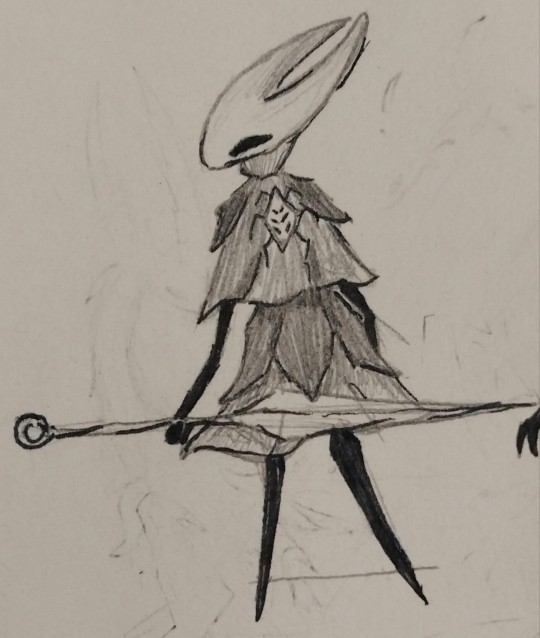

default design
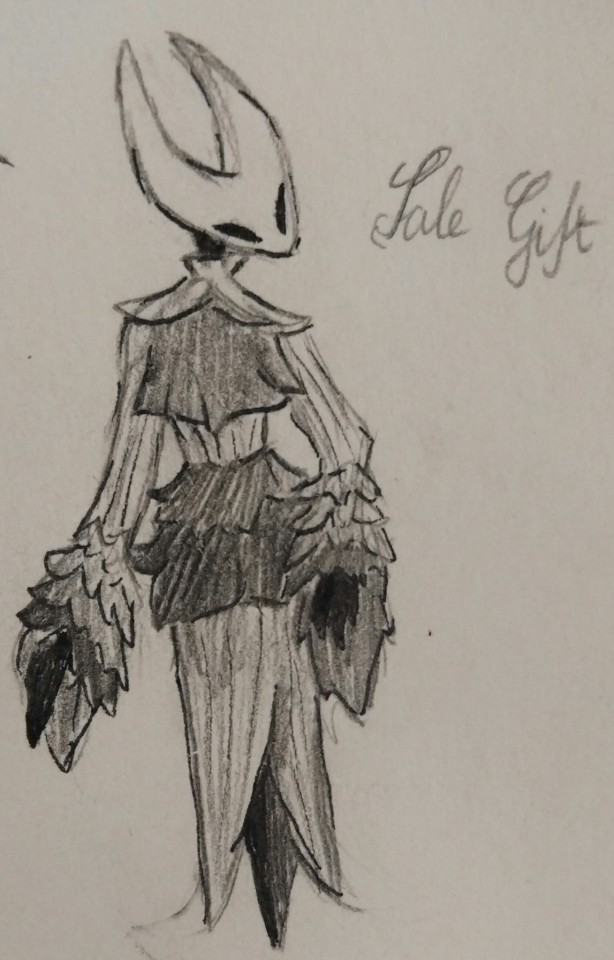
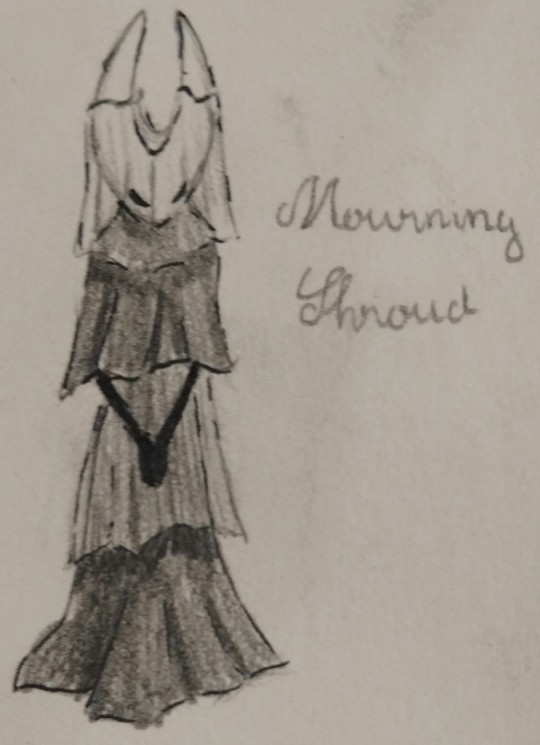
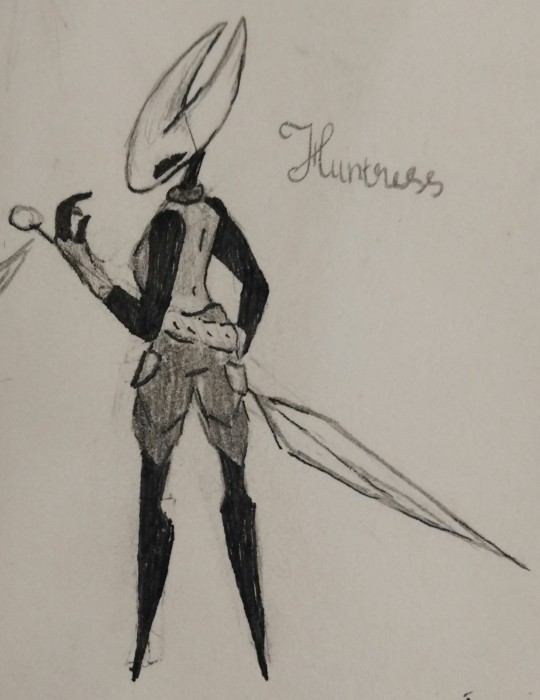
some alts i made
i would've LOVED to make colored versions but unfortunately i drew these on a plane and my colors are in luggage hold TvT
thumbnails and field notes under the cut (as well as the usual bonus doodle)

the pose thumbnails
as you can see, i followed the thumbnails for the lsst two pretty closely, but i had something a little different in mind for the huntress outfit. i wanted tk try something ✨️exotic✨️ so i had her at a cool angle. but then, i had a major skill issue moment and i couldn't replicate the pose on a larger scale. so i just settled for a boring ol' angle from the back ;v;
NOW ON TO THE YAPPING
these notes are mostly for me to reference when i'm drawing em but i hope you all will enjoy them as well
Huntress Outfit
just something practical hormet would wear under her regular cloak AND mainly for when i have a super cool pose i don't want to cover up with her cloak
Mourning Shroud
she would've worn this during and after herrah's ritual. cool long gown and silk veil.
Pale Gift
she was forced to wear this while at the white palace/formal occasions. all of her other outfits (with the exception of her huntress underclothes) are loose, simple, and flowing. this is the opposite; form-fitting, restrictive, and excessively frilly. she HATES this outfit.
PSST bonus pic of hornet's True Form
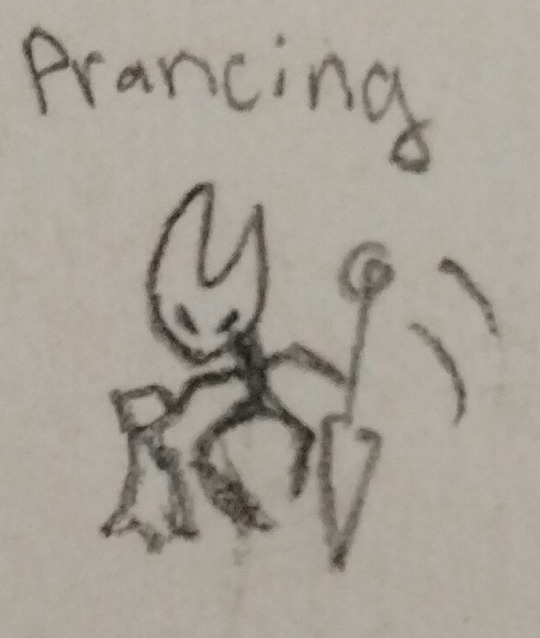
based on the shiny new sprite ofc lol
if you read this far, comment "spooder princess" for Cool Points and a cookie 🍪
30 notes
·
View notes
Text

Googling for poses references por practice and using the first image i stumble upon because i liked on the poses featured
Anyways wow its been a hot minute since i havent drawn anything hs related. This is mostly because i wanted distance from this community but i still really enjoy drawing the characters, ESPECIALLY the hiveswap trolls (if you followed my old blog you might know about it). I missed my wife marsti and her girls
Her milkshake brings all the girls to the yard, i know so
#she would unintentionally cause another alternian revolution because of highbloods who had fallen for her#the others are all jealous#all because of some hot rustblood#imagine#my art#marsti houtek#hiveswap#hiveswap friendsim#and now her girls#folykl darane#skylla koriga#ardata carmia
47 notes
·
View notes
Text
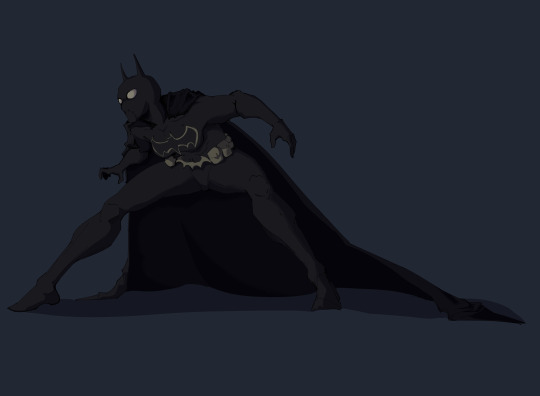
Loose sketch of Cass, that isn't really a loose sketch anymore.
Rant under cut :)
Fun fact, in the middle of this drawing I found out I had the nightlight filter over my screen, so oops.
honestly not much to say about this, I wanted to practice my leg anatomy and some forshortening, but I did that pretty quickly. I suck at colouring, mostly because this month is the first time I have ever tried to colour in flats instead of painting, which is why everything I'm making is so messy. I like making excuses for my mistakes
I still think her legs are wayyy too long- which is a problem I always have, the pose under Steph's drawing I had to shrink by like a third, sooooo
Also here's a lightened version, just with a filter over the top
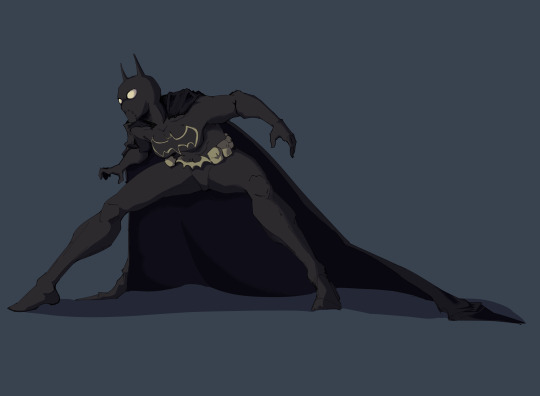
No one look at it too closely. thats rude.
(Quick edit to say that I actually used half of an anatomy reference for this, so proud of myself. you can probably tell by the upgrade in quality, or that might also be because I increased the canvas size by A Lot.)
The shadows are also pretty wrong, if anyone has any tips on that, please let me know! much thanks for the response on my stuff so far, actually wild to reach 100 notes on one thing, so thank you!
#Black bat#batfam#dc fanart#cassandra cain#Black bat dc#cass cain#Black bat fanart#Cassandra cain fanart#idk how to tag this#freezer drawer
97 notes
·
View notes
Note
Hi!! I really love your content (◍•ᴗ•◍). I was wondering how much have you been drawing, I mean, your art skills on anatomy are really great and I would like to ask you if you could give some advices to improve anatomy drawings. Thanks!! ^^
Hi, thank you so much!! ʚ♡⃛ɞ(ू•ᴗ•ू❁)
I have basically been drawing my whole life. I have a very fond memory of when I was 7 years old, and I was drawing cute round animalistic creatures for all of my classmates. And I had a teacher that was great at drawing and they inspired me so much to improve my skills. I started with mostly drawing animals, especially dogs and wolves. I was a huge fan of the anime Ginga Nagareboshi Gin as a kid. (Watched it in the Swedish dub. And it's not really a show for kids, it's kind of brutal.)
How to improve on your anatomy:
I started to focus more on drawing humans in my early teen years, and I was mostly self taught. I used references from art, comics and movies.
I remember when I started to focus more on specific body parts, and the first one that is clear in my memory were wide hips. I got influenced by Tim Burton's movies: Nightmare before Christmas and Corpse Bride. And with a lot more influences from different media, my anatomy improved through the years.
This is how I progressed through the years from 2009 to 2024.



I am that type of artist who enjoys drawing various of art styles. I especially do it to give a specific fiction an identity. That is why I draw my MHA art close to the original MHA style ;)
The recent body parts that've started to put more focus and details on are hip dips and knees. So, Yes! I'm still learning and improving my anatomy.
Practice with simple figures and shapes.



I have come to learn, that using a more simpler style is your best friend when it comes to figuring out shapes. (it's also a useful technique to come up with poses). You can use photo or art references to practice this. I usually use the realistic anatomy details as something I can add later.
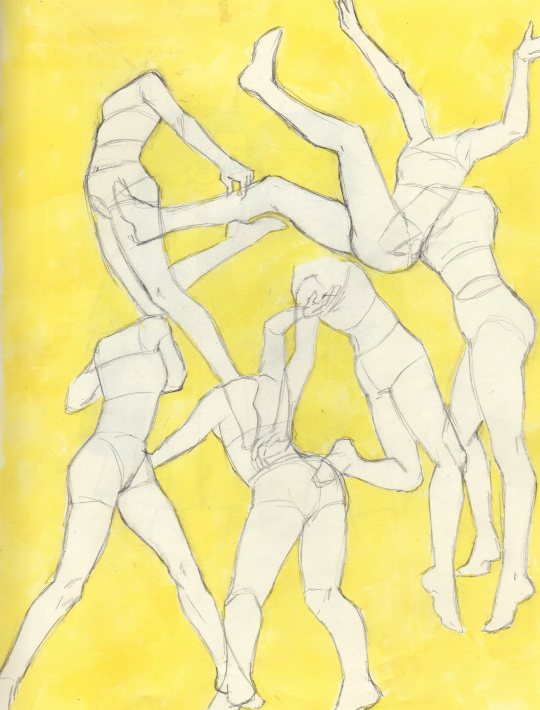



Unfortunately, I don't have much experience with realistic muscle or skeleton studies. Which means that I mostly got my anatomy skills through the view on the skin. But I will still recommend you to study anatomy through muscles and skeleton, because it can be quite useful. I am considering to do it as well
There are though some bone stuff that I put an extra detail on with my anatomy drawing. They're as I mentioned; knees and hips, other ones are: knuckles, clavicles, ribcage, elbow, the ulnar styloid and ankle joint. All of those are often visible because they're less covered in fat and muscles. Which is why I put effort to draw them.
Another highly useful thing about using reference: is to use photos with different angles. I often search for photoshoots with people making different positions, to figure out how it will look at an certain angle. Before Pinterest fucked up, I used to save all my anatomy references over there. But I recently moved them to my external hard drive.


TLDR:
Use references! Practice with simple figures and shapes! View the realistic anatomy as details that you add for more realism.
And the most important! Have fun when you practice Anatomy. Otherwise it becomes frustrating and unfun!
--
I hope my advice was helpful! ฅ(°ω°ฅ) I'm not the best when it comes to explaining anatomy. As I mentioned, I'm mostly self taught. Plus, I rely heavily on my eyes and photographic memories.
22 notes
·
View notes
Note
This might be a bit of a weird question as I know this isn't a drawing blog, but do you happen to have any pointers for finding good reference photos for drawing cane users? I'm having trouble finding interesting/dynamic poses, and the vast majority of pose generator sites I've found don't even show people with mobility aids. Stock photo sites and google are also limited in their usefulness, mostly giving me very stiff poses. If you have any tips that would be great.
hello dearest asker!
I tried to be an artists once upon a time so let me direct you to some things that might help! Here is an excellent post written up by @deoidesign shows how motion and functionality with a cane works. Here is a post by @sparrowsocks on the cane design itself and the practicality of it. Here is another "How To" guide that is a bit more simple but covers how the hand changes with different handles.
Here is a reference of hands gripping cylindrical objects that I think might be a little helpful. Grabbing a cane or just moving it are all things that go into it too.
If you're going for more a historical setting, Here is a library of sources of historical walking sticks and canes. That source is more novelty canes and not for practicality for a mobility aid, but Here is another source for History and it has more practical canes.
Also things like old photo rolls when film was just becoming what we know today could be something helpful too.
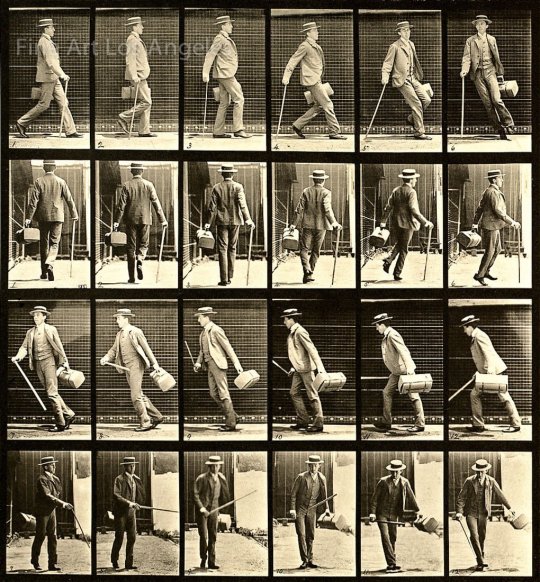
[Image Description: A black and white picture roll of two sets with twelve frames in each. The first roll is a side angle of a man holding a can and walking then taking a right turn and walking back. The second roll is a backside angle of the man walking with the cane and then taking a right turn and walking back.]
We can see for example in the first two frames how the opposite leg moves with the cane.
And of course we have more photos from the Victorian era of men with canes. Granted canes were used largely for fashion but a lot of people did use them for balance and such too. Also they're good references for poses while holding a cane.
Another thing I can recommend is just watching videos of someone using a cane. Look up disabled YouTubers or people who do physical therapy videos and they show largely how movement with a cane should look and more.
If you're looking for dynamic poses I would recommend looking up cosplayers or models who are disabled and use canes. But also looking up disabled actors that use canes or similar mobility aids and go through their filmography is another good way to see references. A lot of disabled people who are artists also post their own photos and videos for art references specifically too.
One last thing is how the character holds their body and what type of cane they need is gonna depend on how they are disabled. Working that out and doing more research is gonna change some things. But also even though there is a proper way to use a cane, some people use canes in different ways to suit their needs and comfort. The biggest example in media is House from House MD and while Hugh Laurie isn't disabled, he does a pretty accurate portrayal of someone using a cane in an alternative way. I personally (when I was getting fitted for one) would use my cane very much as House does, and other people have said much the same.
Hopefully this helps in some way and your fellow artists may be able to throw more help in the notes. Happy drawing!
~Mod Virus 🌸
143 notes
·
View notes
Note
So you're telling me that you draw some of these scrumptious NSFW traditionally??? HOW do you do them so well, do you look up poses/references, or just have that much practice? I'd be grateful for any tips 🙏
Yes, traditionally. In my case, both options work. I use references and have a lot of practice (I've been drawing every day since the end of 2022).
Knowing proportions and anatomy helps me, so I can suggest working on that first. Break the bodies from the reference into simple shapes, e.g. arms and legs are cylinders, joints are spheres, etc. If you can visualize objects in three dimensions, it will be easier. Otherwise, you can use 3D models or articulated artist mannequin.
Learn the location of muscles, how they attach to bones, what bones they attach to, study what they look like from different angles. Not necessarily if your style doesn't involve depicting realistic human anatomy.
I can recommend the books:
Uldis Zarins and Sandis Kondrats Anatomy for Sculptors
Hampton, M. Figure Drawing: Design and Invention
Barcsay, J. Művészeti anatómia (Anatomy for The Artist)


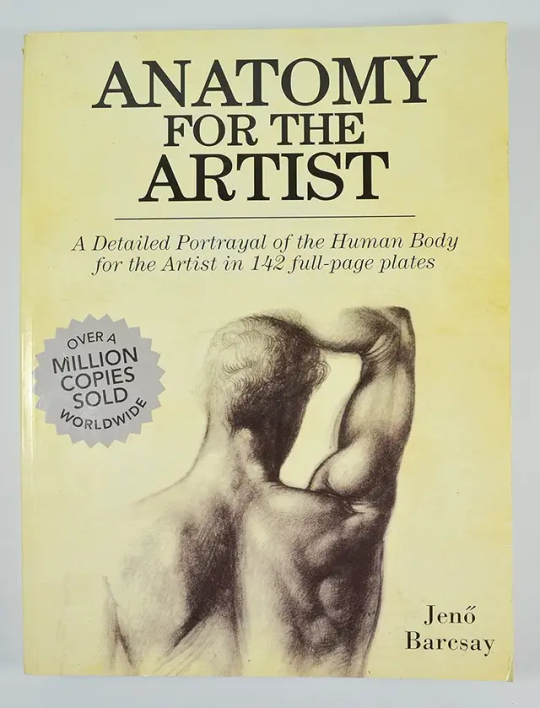
My references for these drawings are mostly all NSFW, some I find on adult sites or Twitter. You can see the muscles very well in these pictures, it's like drawing from nudes in an art studio. But you don't have to use them if you're uncomfortable, the regular ones from Pinterest are just as good!
Using pose references, I usually turn the bodies to a different angle so I don't copy it.
I also draw slower on paper than in digital, one drawing can take hours while I check everything, find mistakes and redraw it, so time plays a role too. I also use a mirror, turn the drawing over and look at it while holding it up to the light, or take a photo and turn it horizontally to see the mistakes. In short, flipping the canvas.
I highly recommend taking breaks. And most importantly, don't be too hard on yourself, drawing should be a joy! If you like challenges, go ahead, if not, don't force yourself to do everything perfectly.
I hope it helps!
#ask#art tips#maybe? idk#by the way#I'm drawing the initial sketch just as depicted on the cover of Michael Hampton's book#sometimes I draw chibis if I get a sudden idea
133 notes
·
View notes
Text
The thing I'm realizing about drawing with dysgraphia is that I need references for every damn thing. It doesn't matter how many times I've drawn it, if I'm doing anything even SLIGHTLY different I need a reference. And if that reference isn't exactly what I need? Well, this drawing is about to look FUNKY.
I have such a hard time keeping proportions in my mind. Such a hard time mentally rotating objects in my mind. I can actually draw a face looking straight ahead pretty well now, but god forbid I am tilting that face in any way. And if the facial features are different? If the nose is smaller or the eyes are squinted or the jaw line is softer? Forget it, throw the whole face away.
"A man is about 8 heads tall" cool cool cool what if he's bending at the waist or bending his knees? What if I want to make a dynamic pose? What if I still make the head too big because I need more space to draw the eyes?
"Here's one way to draw hands" awesome I think I got it but wait I can't make this work if the hands are smaller than a quarter of the page and oops the hands once again look like spaghetti fingers
And then planning where things will go on the page!!!! Guide lines for EVERYTHING and even then, half the time the guidelines won't work and I'll still wind up running out of room or having something look way out of proportion with everything else.
It's frustrating, man. I feel like I wind up mostly doing redraws of other people's work. I was proud of myself when I learned to use a bunch of different references to frankenstein together what I needed, but I'm still hopeless without.
I just hope that if I keep practicing I'll get better with some of this. Even if it took me the better part of 2 decades to write in a straight line with proper spaces between my words.
#art#sam draws stuff#dysgraphia#and then there's my adhd getting impatient with my slow progress#so maybe i am improving#but it's not happening fast enough for the serotonin to hit#I know there's nothing wrong with using references#but sometimes I read a description of a character in a book#and I get the perfect picture in my head#but even with that perfect picture#I cannot translate it to the page#without referring to something else
29 notes
·
View notes